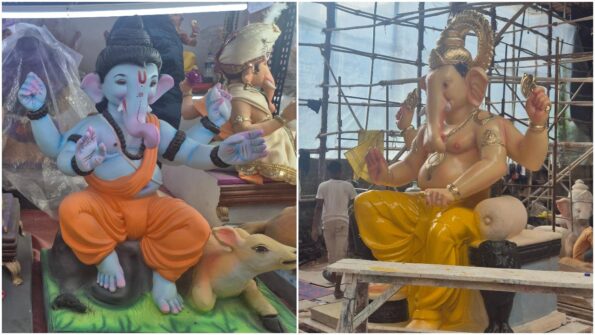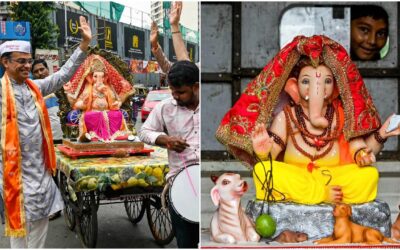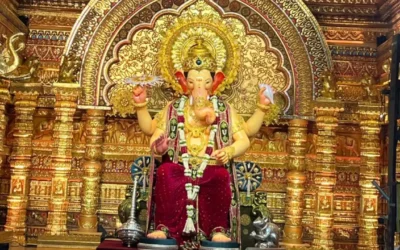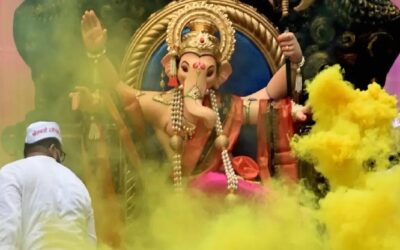Ganesh Chaturthi 2025: A glimpse into the art of making Ganpati idols

[[{“value”:”
On days leading up to Ganesh Chaturthi, Mumbai streets were bustling with festive anticipation and preparations. While this vibrant atmosphere was palpable, a sense of enthusiasm and devotion was also quietly brewing at Ganpati idol workshops where murtikars and artisans were busy giving finishing touches to majestic sculptures that were about to be welcomed at homes, societies and pandals.
Now that the festival has commenced, many Mumbaikars have installed Lord Ganesh idols at home, and many others will be visiting friends and family, and pandals, to seek blessings of Bappa. At the heart of this tradition that is central to Ganeshotsav celebrations are the artists that breathe life into materials, using their art to give birth to something that manages to touch people’s hearts, and create an unparalleled devotional atmosphere.
Every year, one can witness beautiful Lord Ganesh idols of different sizes and themes, yet one thing remains common – how they channel people’s devotion towards Bappa and manage to bring people together in festivities. Whether it is a clay (shadu mitti), papier-mâché or PoP idol, murtikars put in significant time, creativity and effort into conceptualising and creating the Ganpati idols that devotees often can’t stop marvelling at.
Mumbai is home to many renowned sculptors whose next generations are continuing their legacy. Nikhil Rajan Khatu, who has been familiar with this art form since he was a kid, decided to take forward his father Rajan Khatu’s artistic legacy through Kalasagar Arts after the latter passed away during the Covid-19 pandemic.
“I am a third-generation sculptor from the Khatu family, which is known for making Ganpati idols since 1947. My grandfather started it in 1947, and then it continued with my father and uncle (Vijay Khatu). Now, I am continuing my father’s legacy. It has been five years since I have been doing this independently,” he expresses.
Manaswi Manohar Bagwe, who is a lawyer by profession, also refuses to part ways with the artistic legacy of her family which has been sculpting Lord Ganesh idols since 1938. “My grandfather, late Balkrushna Jairam Bagwe, started Bagwe Art in 1938. After him, it was continued by his three sons – Shashikant Bagwe, Manohar Bagwe (Manaswi’s father) and Sadanand Bagwe. I am the third-generation sculptor, and have been learning since I was a kid. For two to three months leading up to Ganesh Chaturthi, my life as a lawyer ends at 5 pm, post which I spend all my time in the workshop, crafting idols. I take a complete leave from my job 15-20 days before the festival to focus on sculpting,” she reveals.
Over the course of time, the making of Ganpati idols has transformed, be it the shift from clay to PoP idols, or from smaller idols to bigger ones. And many murtikars have borne witness to this transformation, adapting their craft to the changing trends.
How Ganpati idols have changed over time
Khatu, who has crafted famous idols like Parel Cha Raja, Andheri Cha Raja and Fort Cha Raja this year along with his team of artisans, specialises in making idols above 10 feet.
“When my grandfather started this, he used to make small idols, from 1 foot up to 6 feet. Later, as the trend changed, my uncle and father took it to 22-24 feet and now, we just make idols above 10 feet. The highest idols we make are about 24-26 feat, and this height cap is mainly so that the idols could pass through the overhead bridges in the city,” he states.
Not only size, but the art of making Ganpati idols has also undergone a transformation in terms of materials used. Bagwe reveals, “When my grandfather started, he used to only make clay idols. After he passed away, the next generation took a chance with PoP. The first major PoP idol we made was Lalbaugcha Raja in 1990, and from then, we started making PoP sculptures as well. Eco-friendly Ganpati idols are either made using shadu mitti or papier-mâché.”
PoP vs clay vs fibreglass vs papier- mâché
Many people might be aware of the ongoing debate on whether making PoP idols should be allowed, given the huge impact it has on the environment. While clay is often suggested as the alternative, there are many intricacies and challenges that accompany each medium.
“We work in both PoP and clay, but bigger idols are made using PoP because of its durability. It is easier to cut and shape using PoP and it dries easily. Quantity is also another major factor. Suppose I make three to four PoP idols in a day, only one clay idol can be created in the same amount of time. So, in two to three months, one can make 100 PoP idols but only 20-25 clay idols,” Khatu explains.
He further states that if one opts for eco-friendly idols, it won’t be possible to deliver the same quantity in the limited period.
Rakesh Ravindra Pawar from Prarambha Kala Arts, who makes idols ranging from 1-3 feet, also believes that making only clay idols has certain challenges. “If a PoP idol takes four hours to complete, a clay idol will take two days. A huge eco-friendly idol cannot be made within two months. Additionally, to make bigger clay idols, murtikars need more space, since these need more time to dry and are also heavier,” he states.
Pawar also reveals that despite the prevalent conversation around buying eco-friendly ganpatis, there is still demand for smaller PoP idols because devotees are often scared about the fragility of clay idols. Also, Ganpati idols made of shadu mitti are more expensive.
Khatu also highlights the cost factor, saying, “Clay idols are 3 to 4 times more expensive than PoP idols so not everyone can afford them. If a 10 feet PoP idol costs around INR 80,000-90,000, the clay idol will be at least three times more expensive.”
While each medium has its own advantages and shortcomings, not many people may know that clay is an omnipresent element in the making of idols. It forms the foundation of PoP idols as well.
“We use clay for the moulding process, face design, etc. So, while the end product is PoP, the base is mitti,” Khatu says.
Bagwe reiterates the fact, saying, “Clay is the foundation of PoP idols as well. If you want to do Master’s in Literature, you need to know the ABCs very well. Clay is like that.”
Apart from PoP and clay, Lord Ganesh idols are also made using fibreglass and papier-mâché. “Fibreglass is more durable, and the idol can stay intact for 10-20 years easily, or even lifetime if maintained properly,” Bagwe explains.
Citing an example, she says, “In 2022, we had made the ‘Australia cha Raja’ idol, which was 20 feet tall and had to be transported to Australia. Because it was made of fibreglass, we could send it disassembled keeping in mind the cargo height limit, and they joined the pieces there through tutorial videos we sent. They have been installing the same idol every year because visarjan of tall idols is not allowed there. This reflects the durability of fibreglass.”
Papier-mâché idols are created using a dough made of soaked paper mixed with other elements, which is then set in a mould. Eco-friendly ganpatis are painted using water-based colours.
The artist behind the art
The murtikars who craft idols of Lord Ganesh often build a connection not only with Bappa but also the craft.
What do they love the most about creating these idols?
“Setting the anatomy of the murti is my skill set. Every part should be in proportion, especially if the idol is in action or there is a different concept. Joining the pieces accordingly is my favourite part,” shares Khatu.
“When we create murtis with a theme, or concept murtis, balancing different elements is my favourite part of the sculpting process,” states Pawar.
For Bagwe, crafting clay idols brings her the most joy. “Making clay idols connects me with the art more. There’s more freedom to work since clay is very flexible and can be moulded into anything you want. That was the first medium I learnt,” she says.
“Additionally, I love that my entire family comes together to craft the idols, making the process even more special,” the artist concludes.
Create your own Ganpati idol
For Ganesh Chaturthi, many people prefer crafting their own eco-friendly Ganpati idols, not only with the objective of protecting the environment but also more actively participating in traditions and festivities.
Mumbai-based artist Meera Nagda, who has been sculpting eco-friendly Ganpati idols and taking workshops for the same for several years, elaborates on the process, saying, “Shadu mitti (eco-friendly clay) is used to make the Ganesh idol. For an eight to 12-inch idol, we typically use around 2-3 kgs of shadu mitti. However, the exact amount may vary depending on the design and details.”
“The trickiest part is probably sculpting the finer details, such as the eyes, nose, and trunk, without damaging the surrounding clay. It requires patience, skill, and attention to detail,” she adds.
If you too want to sculpt your own Ganpati idol for Ganesh Chaturthi next year, or otherwise, Nagda shares a few steps to follow:
Materials required: Shadu mitti, water
Directions:
1. Knead the clay to make it pliable.
2. Create the base shape of the idol.
3. Add details and sculpt the features.
4. Refine and smoothen the surface.
5. Give final touches to complete the idol.
“}]]
Search
Recent
- ‘Bhairav commandos’: Indian army gets specially equipped soldiers; first of 5 units being raised
- Houses flooded, goods destroyed as Mohali gets flooded
- Ambala on alert as Tangri level rises, Haryana minister Anil Vij reviews situation
- Flooded border area halts retreat parade at Hussainiwala
- Finally, MoD grants medical facilities to disabled officer cadets





